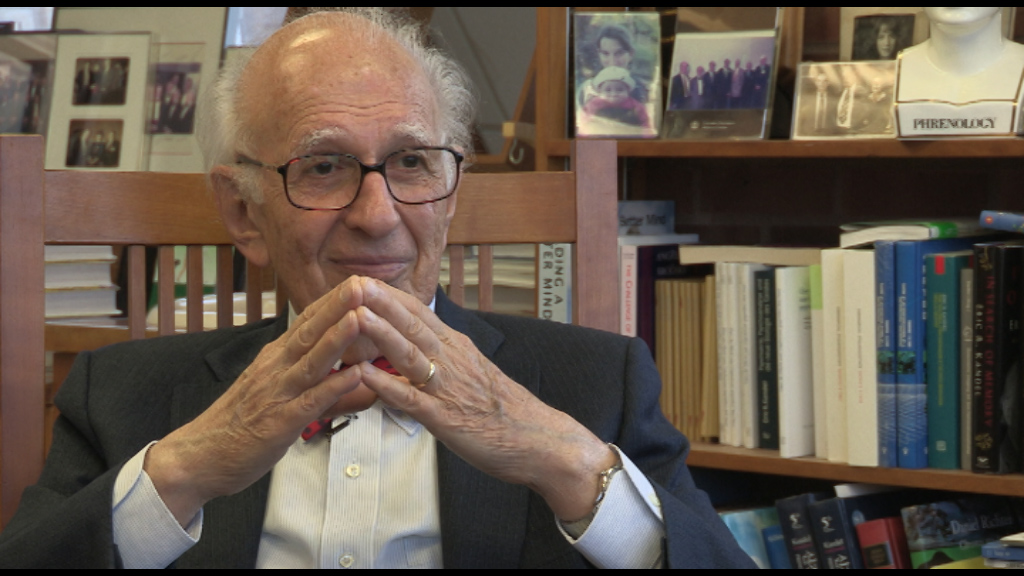NEXT STORY

Cell accepts my article for publication
RELATED STORIES

NEXT STORY

Cell accepts my article for publication
RELATED STORIES


|
Views | Duration | |
|---|---|---|---|
| 31. An exceptionally rewarding year | 75 | 01:14 | |
| 32. Driven to study Aplysia by a sense of adventure | 78 | 01:40 | |
| 33. Being in the right place at the right time | 86 | 01:24 | |
| 34. Setting up my own lab | 76 | 01:28 | |
| 35. Mapping the ganglion | 69 | 00:41 | |
| 36. Recording connections between cells | 65 | 02:27 | |
| 37. Moving to New York | 63 | 02:12 | |
| 38. Division for Neurobiology and Behavior | 95 | 05:08 | |
| 39. Exploring the mechanism behind habituation and dishabituation... | 132 | 04:41 | |
| 40. A good syllabus is like a symphony | 63 | 03:17 |


I wrote a book modestly entitled the Cellular Basis of Behavior: An Introduction to Behavioral Neurobiology, in which I pointed out that a general approach was emerging, which could be useful in approaching not only simple behaviors, but ultimately more complicated behaviors, analyzing not only short-term memory, but also long-term memory. And I wrote it so that it was useful not only for a scientist working in the field, but also for graduate students. And people began to develop a number of preparations – Hermissenda, Limax, etc – to look at simple forms of learning in simple animals, crayfish. And we were, of course, now inspired to go on and look at the molecular mechanisms for long-term memory. And that opened up a beautiful area of research.
First of all, Jimmy and I went back and tried the same thing we'd tried earlier - inhibitors of protein synthesis - and we again found they had no effect on short-term memory, but they selectively blocked long-term memory. So the question arose: how does long-term memory arise? Well, we knew that if it was new protein synthesis, it quite possibly involves alteration in gene expression. And at that point, two things happened. One, I was joined by Philip Goelet in the laboratory. And he'd come from Sydney Brenner's lab and was very au courant on molecular biology. And two, we had just moved to Columbia, and there all kinds of things opened up.
So 1973, we received an offer to come to Columbia, for several reasons. They had a neuroanatomy course run by a guy called Malcolm Carpenter, and he was beginning to wear on students. He was not very exciting, and he was slightly sadistic, and they wanted to get a more effective teaching of neuroscience which they realized was becoming more and more important. And at NYU we'd developed a quite good neuroscience course, and we began to develop a good syllabus for neuroscience, because we thought - I thought - that I don't want students sitting there during a lecture and just scribbling things down. I want them to listen to it as if listening to a symphony, to sort of take it in. So I would hand them out what they needed to know.
We came to Columbia, we gave a course, the first year was very successful - I was elected teacher of the year - the syllabus ultimately became a textbook, Principles of Neuroscience, and our course and the science that our faculty did was very well regarded.
Eric Kandel (b. 1929) is an American neuropsychiatrist. He was a recipient of the 2000 Nobel Prize in Physiology or Medicine for his research on the physiological basis of memory storage in neurons. He shared the prize with Arvid Carlsson and Paul Greengard. Kandel, who had studied psychoanalysis, wanted to understand how memory works. His mentor, Harry Grundfest, said, 'If you want to understand the brain you're going to have to take a reductionist approach, one cell at a time.' Kandel then studied the neural system of the sea slug Aplysia californica, which has large nerve cells amenable to experimental manipulation and is a member of the simplest group of animals known to be capable of learning. Kandel is a professor of biochemistry and biophysics at the College of Physicians and Surgeons at Columbia University. He is also Senior Investigator in the Howard Hughes Medical Institute. He was the founding director of the Center for Neurobiology and Behavior, which is now the Department of Neuroscience at Columbia University. Kandel's popularized account chronicling his life and research, 'In Search of Memory: The Emergence of a New Science of Mind', was awarded the 2006 Los Angeles Times Book Award for Science and Technology.
Title: A good syllabus is like a symphony
Listeners: Christopher Sykes
Christopher Sykes is an independent documentary producer who has made a number of films about science and scientists for BBC TV, Channel Four, and PBS.
Tags: Philip Goelet
Duration: 3 minutes, 17 seconds
Date story recorded: June 2015
Date story went live: 04 May 2016